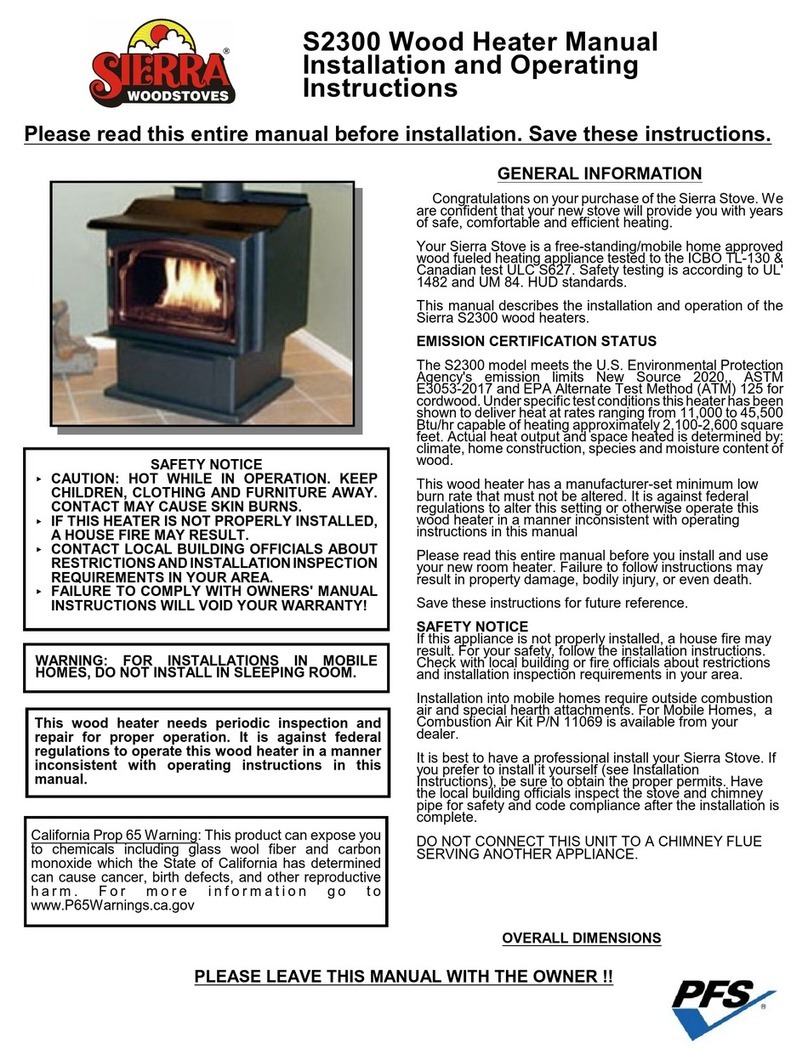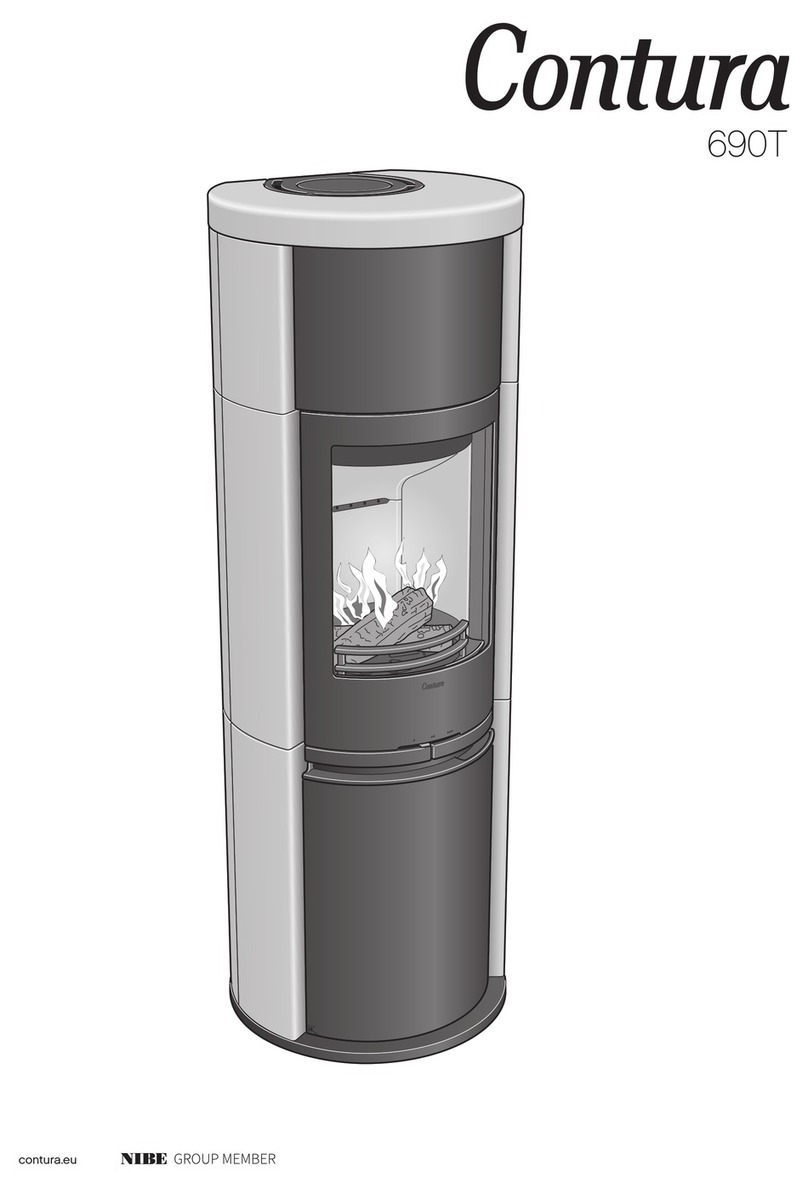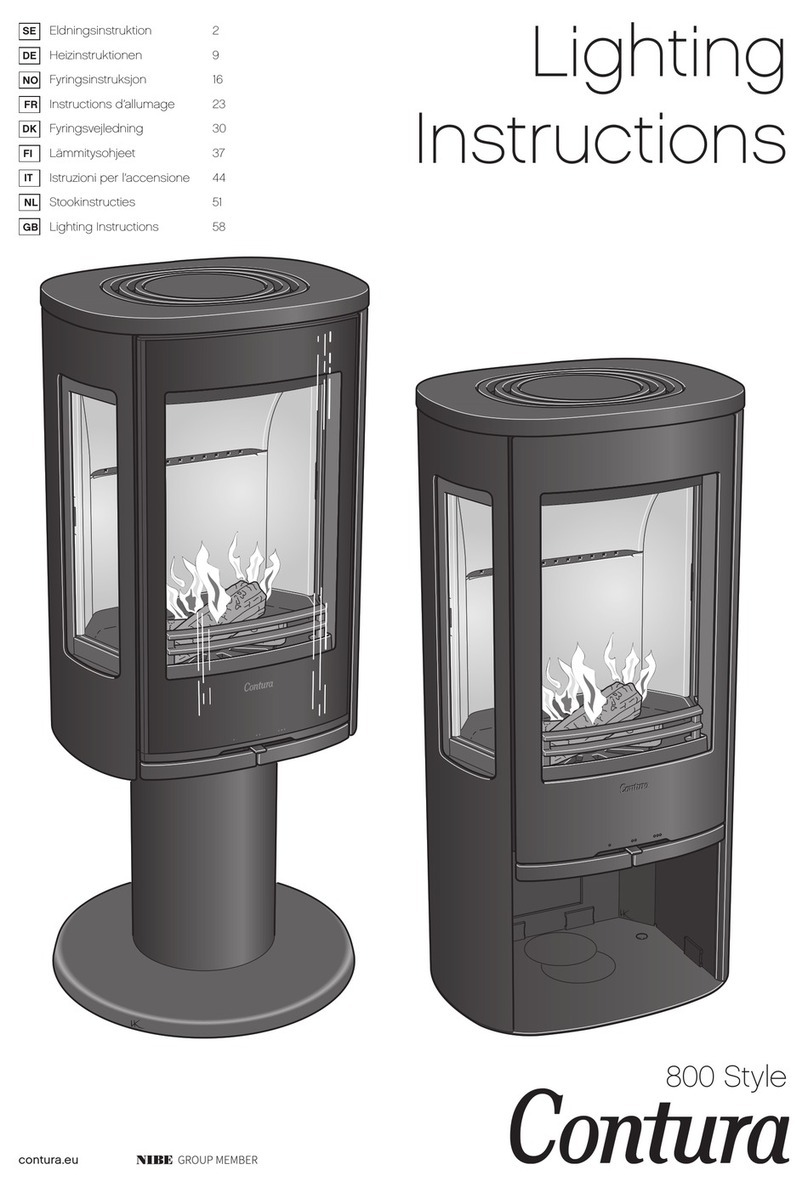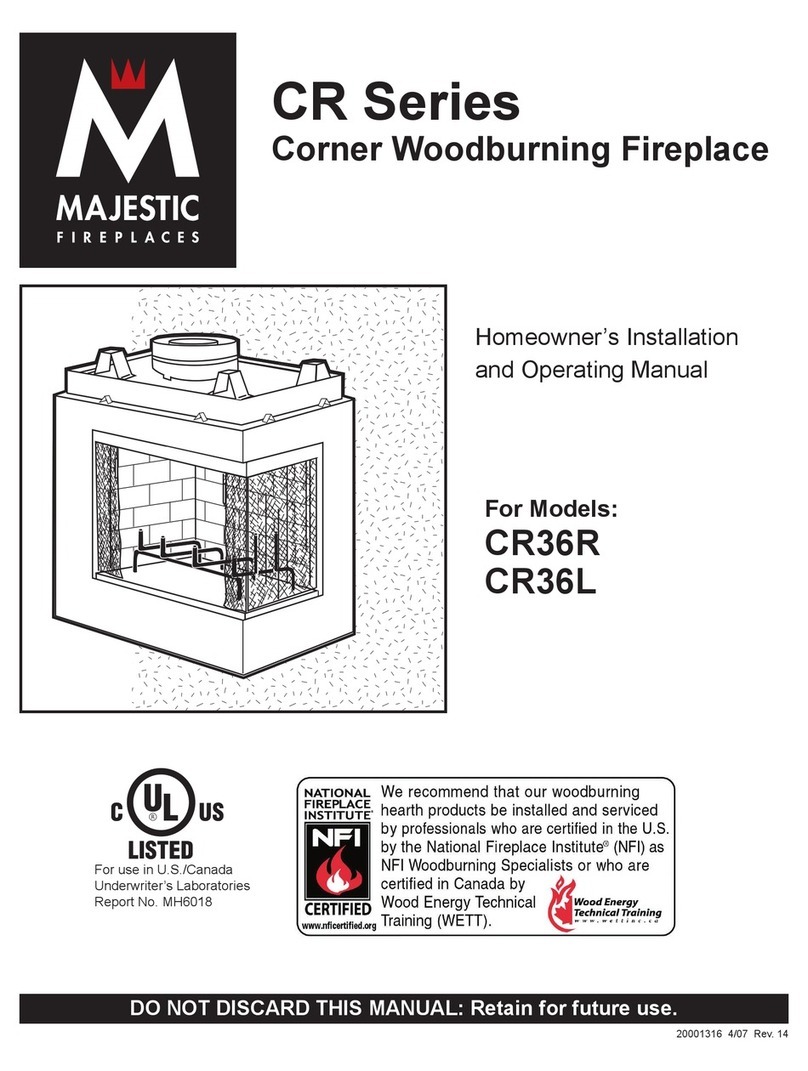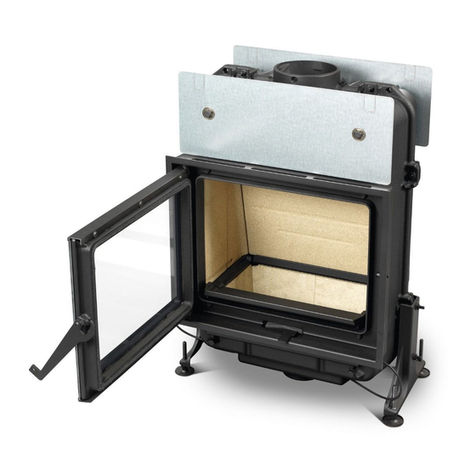Sierra Woodstoves Shenandoah R77-E Manual

SAFETY NOTICE
<CAUTION: HOT WHILE IN OPERATION. KEEP
CHILDREN, CLOTHING AND FURNITURE AWAY.
CONTACT MAY CAUSE SKIN BURNS.
<IF THIS HEATER IS NOT PROPERLY INSTALLED,
A HOUSE FIRE MAY RESULT.
<CONTACT LOCAL BUILDING OFFICIALS ABOUT
RESTRICTIONS AND INSTALLATION INSPECTION
REQUIREMENTS IN YOUR AREA.
<FAILURE TO COMPLY WITH OWNERS' MANUAL
INSTRUCTIONS WILL VOID YOUR WARRANTY!
DO NOT CONNECT THIS APPLIANCE TO A CHIMNEY
FLUE SERVING ANOTHER APPLIANCE.
DO NOT CONNECT TO ANY AIR DISTRIBUTION
DUCT OR SYSTEM
FAILURE TO FOLLOW INSTRUCTIONS MAY
RESULT IN PROPERTY DAMAGE, BODILY INJURY,
OR EVEN DEATH.
NOT APPROVED FOR MOBILE HOMES.
DO NOT USE CHEMICALS OR FLUIDS TO START
THE FIRE!
DO NOT BURN GARBAGE OR FLAMMABLE FLUIDS.
ALL SHENANDOAH SOLID FUEL ROOM HEATERS
HAVE BEEN TESTED IN ACCORDANCE WITH
U.L.TEST STANDARD 1482-1998 TEST STANDARD
1482-1998
Shenandoah R77-E Wood Burning
Heater Manual (EPA Exempt)
Installation & Operating Instructions
Please read this entire manual before installation. Save these instructions.
GENERAL INFORMATION
Congratulations on your purchase of the Sierra Stove. W e
are confident that your new stove will provide you with years
of safe, comfortable and efficient heating.
This manual describes the installation and operation of the
Shenandoah R-77E wood burning heater.
Please read this entire manual before you install and use
your new room heater. Failure to follow instructions may
result in property damage, bodily injury, or even death.
Save these instructions for future reference.
SAFETY NOTICE
If this appliance is not properly installed, a house fire may
result. For your safety, follow the installation instructions.
Check with local building or fire officials about restrictions and
installation inspection requirements in your area.
It is best to have a professional install your Sierra Stove. If
you prefer to install it yourself (see Installation Instructions),
be sure to obtain the proper permits. Have the local building
officials inspect the stove and chimney pipe for safety and
code compliance after the installation is
complete.
PLEASE LEAVE THIS MANUAL WITH THE OWNER !!
Listed by Warnock Herseyl

2
These instructions are to be used in conjunction
with the fire codes and ordinances for your specific
area which can be obtained from your local
building inspector for Fire Marshall. If required, the
proper permit must be obtained! To protect your
family and property, you should determine the
applicable codes and ordinances and strictly
adhere to them.
INSTALLATION INSTRUCTIONS
• Installing a wood or coral heater is different than
other fuel burning appliances.
• Failure to install correctly could result in a serious
fire with loss of life and property.
A proper draft is absolutely essential to achieve
satisfactory performance.
• Too little draft will cause poor burning and
smoking.
• Too high a draft will cause the unit to burn too hot
and use excessive fuel.
• The draft reading should be from .04 to .07 inches
of water column (.06 W.C. is the desired draft). It
is the responsibility of the user to obtain the
proper draft range.
• Low draft conditions may be corrected by using a
larger flue pipe, shorter connector pipe, or
extending the chimney height.
• High draft conditions may be corrected by
installing a barometric damper.
• A qualified serviceman should be consulted of
correction of chimney draft.
A. CHOOSING A LOCATION
A central location is most desirable, however, the
minimum required run of pipe to the chimney
should be the deciding factor.
Shenandoah Heaters must use an approved
system for venting flue gases. Figures
2 - 5 indicate various methods.
B. PRIOR TO INSTALLATION
1. Remove carton, crating and all packing
material from the heater.
2. Fire the stove outdoors to cure the paint, and
burn off odor of oils and solvents used in
manufacturing. Could cause unpleasant odors
in the home.
C. CLEARANCE FOR SHEANDOAH HEATERS (Floor
Protector)
1. SET THE HEATER ON A NON-COMBUSTIBLE
FLOOR PROTECTOR WITH AN R-VALVE OF
1.0 OR LISTED FLOOR PROTECTION that
covers an area 8” larger than the heater on
three sides and extends 16” beyond the ash
and loading doors and under the chimney
connector 2” beyond each side.
2. IF APPROVED FLOOR PROTECTION IS NOT
USED: Use the following calculation to
determine if a proposed alternate floor
protector meets the requirements listed in the
appliance manual.
a. Convert specification to R-value.
i. R-value is given – no conversion is needed.
ii. K-factor is given with a required thickness
(T) in inches: R = 1/k x T
iii. C-factor is given: r = 1
b. Determine the R-value of the proposed
alternate floor protector.
i. Use the formula in step (a) to convert
values not expressed as ”R”.
ii. For multiple layers, add R-values of each
layer to determine the overall R value.
c. If the overall R-value of the system is greater
than the R-value of the specified floor
protector, the alternate is acceptable..
Example:
The specified floor protector should be ¾ inch
thick material with a K-factor of 0.84. The
proposed alternate is 4” brick with a C-factor of
1.25 over 1/8” mineral board with a K-factor of
0.29.
Step (a.) Use the formula above to convert
specification to R-value.
R = 1/k x T = 1/0.84 x .75 = 0.893
Step (b.) Calculate R of proposed system
4” brick of C= 1.25, therefore
R brick = 1/C = 1/1.25 = 0.80
1/8”mineral board of k=0.29, therefore
R min.bd = 1/0.29 x0.125 = 0.431
Total R = Rbrick + Rmineral board =
0.8 + 0.431 = 1.231
Step (c.) Compare proposed system R of 1.231 to
specified R of 0.893. Since proposed
system R is greater than required, the
system is acceptable.
Definitions:
Thermal Conductance = C = Btu = W
(hr)(ft )(F) (m )(K)
2B2B
Thermal Conductance =
k = Btu = W = Btu
(hr)(ft )( F) (m )( K) (hr)(ft)( F)
2B2BB
Thermal Conductance = R = (ft )(hr)( F) = (m )( K)
2B2B
Btu W
3. Do not install in closets or alcoves.
4. Keep combustibles at least three feet from the
heater. This includes furniture, magazine racks,
rugs, clothing and firewood.
Do not dry clothes on or within three feet of the
heater, or store flammable liquids in the same room
as the heater.
Minimum clearances from combustible materials
without protection:
Model R77 ( See figure 1)
Sides Back Fuel Door Top Connector Pipe
A B
36" 36" 36" 36" 18"
5. Minimum clearances from combustible materials
with protection:

3
Figure 1
Figure 2 Figure 3
The distances between the sides and/or back can be
reduced by placing an approved wall protection
panel over the combustible walls.
Consult NFPA 211 for reduced clearances allowed a
proper installation.
D. Connector Pipe Installation
This connector pipe connects the heater to the
chimney.
On Shenandoah heaters, this pipe should be at
least 6 inches in diameter, 24 gauge, or heavier,
black pipe.
It is recommended that connector pipes be
installed with the crimped end down, including the
section which goes into the heater collar. In this
way, any possible creosote formation will drain
down the inside pipe.
(The R77-E comes equipped with a cast iron
damper in the flue collar. You may need to cut
slots in your stove pipe to fit over the damper rod.)
IMPORTANT: ALL PIPE JOINTS AND THE
CONNECTION TO THE HEATER COLLAR SHOULD
BE SECURED WITH AT LEAST THREE METAL
SCREWS.
The connector pipe should be at least 18 inches or
more from combustible materials.
The connector pipe should be as straight and
short as possible (keeping minimum clearances in
mind). It should have no more than two 90 degree
elbows.
The horizontal connectors are required by NFPA
(National Fire Protection Association) No.211 to
have at least ¼ inch rise to the linear foot. It
should be easily accessible for cleaning, and
should not pass through walls, floors or ceiling
without being properly insulated for heat.
The connector pipe should not be installed outside
or through unheated inside areas because
condensation of hot gasses coming in contact
with a cold pipe will cause rapid creosote
accumulations.
THIS ROOM HEATER MUST BE CONNECTED TO:
(1) A Listed Type HT (2100F) chimney per UL 103
or ULC S629
(2) A code-approved masonry chimney with a flue
liner. The chimney size should not be less than
or more than three times greater than the cross
sectional area of the flue collar.
CHIMNEY CONNECTOR SYSTEMS AND
CLEARANCES FROM COMBUSTIBLE WALLS FOR
RESIDENTIAL HEATING APPLIANCES
A. Minimum 3.5 inch thick brick masonry all framed
into combustible wall with a minimum of 12 inch
brick separation from clay liner to combustibles.
The fireclay liner shall run from outer surface of
brick to wall, but not beyond the inner surface of the
chimney flue liner and shall be firmly cemented in
place.

4
Figure 4
B. Solid insulated, listed factory-built chimney
length of the same inside diameter as the
chimney connector and having 1 inch or more
of insulation with a minimum 9 inches air
space between the outer wall of the chimney
length and combustibles.
C. Sheet steel chimney connector, minimum 24
gauge in thickness with a ventilated thimble,
minimum 24 gauge in thickness, having two 1
inch air channels, separated from
combustibles by a minimum of 6 inches of
glass fiber insulation. Opening shall be
covered, and thimble support with a sheet
steel support, minimum 24 gauge in thickness.
D. Solid insulated, listed, factory-built chimney
length, with an inside diameter 2 inch larger
than the chimney connector, and having 1 inch
or more of insulation. Serving as a
pass-through for a single wall sheet steel
chimney connector of minimum 24 gauge
thickness, with a minimum 2 inch air space
between the outer wall of the chimney section
and combustibles. Minimum length of a
chimney section shall be 12 inches chimney
section spaced 1inch away from connector
using sheet steel support plates on both ends
of chimney section. Opening shall be covered,
an chimney section supported on both sides
with sheet steel support securely fastened to
wall surface of minimum 24 gauge thickness.
Fasteners used to secure chimney section
shall not penetrate chimney flue liner.
E. Proper Draft
The chimney draft greatly influences the operation.
Too little draft can cause smoke to puff from the
thermostat damper or from the door. To increase
draft: use a larger flue pipe, shorten connector
pipe or extend chimney height. Too much draft
could cause overheating. A barometric damper
installed in the connector pipe close to the heater
can control excessive draft.
The flue area of the chimney should be a minimum
area equivalent to 6" diameter flue pipe.
If necessary, the draft can be checked by qualified
serviceman and should have a draft of .04 inches
of water column minimum and .07 maximum.
Chimney Draft
1 . Factory Build Chimneys: Must be listed type
HT per UL 103. NFPA No.211 requires factory built
chimneys to be listed and installed in accordance
with conditions of the listing and the
manufacturer’s instructions. NFPA No.211 also
requires the chimney to extend at least 3 feet
above the highest point where it passes through
the roof, and at least 2 feet higher than any portion
of a building within 10 feet of the pipe. (See
figures 2 & 3)
2 . Brick Chimney with Thimble: When an existing
chimney is used be sure it is in good repair and
has a suitable chimney flue liner.
A solid fuel heater should not be connected to the
same chimney as other heating appliances.
Unsatisfactory performance can result from
variable or insufficient draft.
A connector to masonry chimney shall extend
through the inner face or liner but not beyond, and
shall be firmly cemented to masonry chimney. A
thimble may be used to facilitate removal of the
chimney connector for cleaning, in which case the
thimble shall be permanently cemented in place
with high temperature cement (see figure 4).

5
Figure 5
3 . Brick Chimney with Fireplace: The heater can
be vented into the fireplace by sealing the
opening with noncombustible material and
material and extending the connector pipe into
the chimney damper. Refer to your local codes
(see Figure 5).
A. Bi-metal Thermostat Control
Shenandoah Heater are thermostatically
controlled, but do need reasonable attention to
assure efficient and trouble free operation, The
thermostat controls the damper providing an
increase or decrease in combustion air to the fire.
Adjustment for comfort is necessary.
• Turn knob toward “HIGH” to increase heat output.
• Turn knob toward “LOW” to decrease heat output.
B. Before building the First Fire
1. Combustible materials must be kept at least
three feet from the stove. This includes
furniture, magazine racks, rugs, clothing and
firewood. Do not dry clothing or within three
feet of the heater, or store flammable liquids in
the same room with the heater.
2. Occasionally the movement and the handling
of the unit affects the bi metal thermostat and
damper controls. Prior to building the firs fire,
check the operation of the thermostat damper.
With a flashlight, shine light through the top of
the thermostat cover and observe the damper
as the control knob is moved from low to high,
the damper must move freely and have no
hesitation in either the up or down movement.
If hesitation or sticking occurs, have the
thermostat corrected.
3. Check the grate operates to assure it is in
position and operates properly. Do not burn
the stove without the grates in place.
4. Additional grates or support of fire is not
needed.
C. Starting the Fire and Burning Techniques
Warning: Do not use gasoline, gasoline type
lantern fuel, kerosene, Charcoal lighter fluid or
similar liquids to start or ‘freshen up’ a fire in this
heater. Keep all such liquids well away from the
heater.
DO NOT BURN garbage, gasoline, naphtha, engine
oil or any flammable liquids or chemicals or burn
you stove without grates in place.
DO NOT IN ANYWAY CAUSE THE UNIT TO
OVER-FIRE BY OVERRIDING THE THERMOSTAT
CONTROL.
This is an unsafe operation of the unit and could
severely damage the unit as well as endanger your
home. For this reason, this type of operation
would invalidate the warranty.
Burning Wood
To start a wood fire, place crumpled newspaper on
the grate and cover it with kindling wood in a criss
cross pattern. Then place larger sticks on top of
the kindling. Before lighting the paper, be sure the
thermostat control is on “HIGH” and the flue
damper is open.
After lighting, close the door and latch. Place
additional wood in the heater as desired after a fire
bed is established and adjust the damper. Adjust
the thermostat from time to time until the desired
comfort is obtained. The bi-metal thermostat will
automatically control the combustion air to the fire
thus maintaining the desired heat output.
Types of wood
Split dry hardwoods (20% moisture levels) is
recommended for the best performance. This will
produce 5,500 to 6,000 BTU per pound. A mixture
of green and dry wood will produce satisfactorily.
Wet and green wood will reduce the heat output of
the unit because the BTUH output is reduced by
the moisture content during the early stages of the
burn.
Burn time
Depending on the type of wood (hard or soft) and
the bi-metal thermostat setting, a variable burn
time can be obtained. With a full firebox of
hardwood at low setting, an overnight (8 to 10
hours) burn can normally be obtained.
Adding wood to the fire box
1. Open smoke outlet damper. FULL OPEN.
2. Open door slowly to allow air to move into the
firebox without creating a turbulence
3. Check buildup under coals with poker, and if
tight, loosen up and force some ash into the
ash pan. This may also be done with the
shaker grate before wood is added.
4. Place wood on hot coals with small pieces at
the bottom.
5. Close door and latch.
If fire bed is small, move the thermostat knob to
HIGH and fire will recover more quickly. Then
adjust to lower setting.
If fire bed is large and hot, no adjustment to the
thermostat know is necessary.
Adjust the smoke outlet damper after the fire has
rekindled.
Opening the Fill Door

6
Making sure smoke outlet damper is FULL OPEN,
open the door ½ inch for 15 seconds before
opening it completely. This provides a slow
combustion of the accumulated gases above the
fire rather that a sudden burst of flame caused by
the introductions of oxygen. This will also allow
smoke to move out of the heater more completely.
D. Ash Control and Removal
For best results, shake down ashes until live coals
start to fall. Remove the ashes when the fir is low
prior to adding fuel. This should be done daily or
as often as required to avoid ash buildup.
DO NOT allow ashes to build up to the grate level
as this will cause intense heat on the grate ans
cause it to warp and have a short life. Inspect the
area around the ash pan and clean out as required.
For disposal of ashes, places ashes in metal
container with a tight fitting lid. The closed
container of ashes should be placed on an
incombustible floor or on the ground, well away
from all combustible materials, pending final
disposal. If ashes are disposed of by burial in the
soil or otherwise locally dispersed, they should be
retained in the closed container until all cinders
have thoroughly cooled.
DO NOT USE A PAPER BAG OR BOX.
E. Creosote Formation and Removal
When wood is burned slowly, it produces tar and
other organic vapors which combine with expelled
moisture to form creosote. The creosote vapors
condense in the relatively cool chimney flue of a
slow burning fire. As a result, creosote residue
accumulates on the flue lining, the connector pipe
and within the heater. When ignited, this creosote
makes an extremely hot fire.
If this happens, the fire department should be
called immediately. Extinguish the fire in the heater
by dumping a large quantity of course salt on the
fire, or by using a dry powder to keep air from
entering the chimney. If possible, do not use water
to extinguish a chimney fire because it could
damage the flue liner. If there is a major creosote
problem, have the chimney, stove pipe and heater
cleaned and inspected before firing the heater
again.
In addition to being a fire hazard, the presence of
creosote will affect the performance by reducing
the draft. This may cause smoking from the fill
door or cause the inability to hold a fire.
The chimney connector and chimney should be
inspected at least once every two months during
the heating season to determine if a soot buildup
has occurred.
To reduce Creosote Problem:
1. Use dry wood.
2. Burn a hot fire for approximately 30 minutes
daily.
3. Keep stack temperature above 250 degrees
Fahrenheit. Below 250 degrees Fahrenheit
produces black liquid creosote.
4. Rather than burn the heater extensively at a
low setting during the mild temperatures of 50
degrees and above, build a small hot fire for a
short period of time.
Chimney inspection and cleaning
The chimney and heater should be inspected for
creosote buildup every two weeks during the
heating season. Creosote is recognizable as a
black oily or flaky deposit on the walls of the
heater and flue. If creosote has accumulated, it
should be removed to reduce the risk of a chimney
fire.
PERFORMANCE TIPS
A. If your heater SMOKES, has LOW HEAT
OUTPUT, or CANNOT MAINTAIN A FIRE, review
the following:
1. The chimney draft must be at least .04" W.C.
with .06" W.C. the recommended draft.
2. Clean creosote deposits from the chimney and
connector pipe.
3. The connector pipe from the heater to the
chimney may be too long. Reposition the
heater, if possible, for minimum clearances.
4. Do not have more than two 90 degree elbows
in the connector pipe.
5. Horizontal connector pipe must have 1/4" rise
per linear foot.
6. Use a chimney cap to reduce down drafts in
the chimney.
7. More than one heating appliance connected to
the same chimney flue can affect the draft.
8. Ash clean out at the chimney base must be
sealed with the door closed tightly.
9. Remove tree limbs that are too close to
chimney.
10. The chimney height may not be adequate for
proper draft. Increase height if necessary.
11. Burn small hot fires instead of heavily loaded
smoldering fires in mild weather.
12. Sufficient combustion air may not be available
to the heater. This can occur in some newly
constructed highly insulated “light” houses.
Open a window I the rom in which the heater is
located., If this helps, then outside air must be
piped tot he damper area of the heater. Consult
your dealer for assistance.
B. Fire Burns Too Hot or Too Fast
1. Check door gasket for proper seal.
2. Be sure knob is set to LOW setting.
3. Check combustion air damper. Be sure it is not
sticking open. (See section B under Operating
instructions)
4. For wood burning, allow ashes to build up on
grate.
5. Check chimney draft - .07" W.C. maximum.
6. High winds or prevailing winds may cause
excessive draft.
7. Install a barometric damper in pipe to reduce
drat.
8. Contact dealer for assistance.
C. Fire Goes Out
1. Check chimney draft. Should be no less than
.04" W.C. but .06" is recommended.
2. Shake down ashes more frequently.
3. Use poker with tip vertical and down to remove
ashes from the edges of the grate next to the
firebrick.
4. Remove the ashes. Do not allow them to build
up under the grate in the ash pan.
5. Keep pipe damper open until fire has rekindled.
6. Adjust damper control knob for increased
combustion air.

7
PERFORMANCE TIPS (continued)
7. If wood has been burned previously, check
chimney for creosote buildup.
Clean as necessary.
8. Chimney cap may be too restrictive.
D. Heater Makes Noise
Metal cools off and contracts when it gets hot and
cools off. This may cause the heater to
occasionally give off some thumping and banging
noises. The noises should not be to a distractive
level nor reoccur while the heater is hot.
As wood burns, a log will often roll off the pile and
strike the side or front of the stove. It will create a
moderate thumping noise.
E. Unit Warps or Bows Slightly
As metal expands under heat, it has to move. This
will tend to increase as the fire gets hotter. As the
heater cools off, the metal will return to near
original conditions. It is not abnormal or in any
way hazardous to have a minor change in metal
flatness after having been heated.
MAINTENANCE INSTRUCTIONS
Long life and performance of the heater is directly
related to proper maintenance. Please follow these
suggestions.
A. Summer Storage
If the heater is removed during the off-season,
store it in a dry place to prevent rust. Before
storing, remove the ashes, clean, and touch up the
paint where needed. A high temperature paint is
available from your dealer.
B. Yearly Flue Inspection
Each year before putting the heater into service,
the chimney flue should be cleaned of soot and
other residues, and inspected for needed repairs or
any accumulation of creosote. The inspection is in
addition to the bimonthly inspections during the
heating season.
C. Creosote Removal
Creosote should be removed from the chimney
using appropriate brushes and tools. These are
available through many stove dealers and hardware
stores. Care should be taken to avoid damaging the
flue liner. Chimney cleaning service is available in
most areas.
D. Firebrick Inspection
At least once a year, check the condition of the
firebrick lining. All broken firebricks should be
replaced. New firebrick can be obtained from your
Shenandoah dealer.
SERVICE TIPS
(To be Performed Only by Qualified Installers)
Re-calibrating Thermostat Control
Note: All calibration is done at approximately 70
degrees Fahrenheit
The heat output of the stove is controlled by the
draft opening. This operates automatically by the
bimetal thermostat opening and closing the
damper plate. The normal temperature operating
range is preset at the factory.
It is rare, but possible, for the operating range to
change after the heater is put into use.
The control should be re-calibrated for peak
performance as follows:
1. Turn control knob counter clockwise until
pointer is against stop pin.
2. Remove control knob from stem.
3. Turn stem until the damper plate is
completely closed.
4. Turn stem clockwise until damper plate
starts to open.
5. Replace know with the pointer directed to
Second indicator mark past LOW
(See Diagram above)
A. Door Adjustments
Occasionally it is desirable to improve its
operation or the seal between the door and frame.
This can result from minor changes due to normal
metal expansion after being subjected to heat.
By determining the type of adjustment desired, the
following procedure will make it simple and quick.
1. If door is tight on hinge side thus causing the
door to feel springy just prior to latch, loosen
hinge plates (2 bolts each) and allow to move
outward slightly. Do not allow to move out far
enough to lose the seal between the door
frame and gasket.
2. If Door latch opens and closes hard, tap door
catch down slightly.
3. If door latch opens and closes too easily, tap
door catch up slightly. (See Diagram -Page 8)

8
Door Adjustment
Sierra Products, Inc.
5061 Brooks St., Ste B
Montclair, CA 91763
(909) 399-3355
Should you have a warranty claim on your Sierra-Sierra Stove, notify your nearest dealer, or
contact Sierra Products, Inc. at the above address.
R77 Replacement Parts List
100045.1 Metallic Black Touch Up #3609
410079 Thermostat Brass Rod R65/ 77
410080 Thermostat Knob R65/77
410081 Flue Damper R65/77
410082 Outer Grate Ring R65
410084 R77 Center Grate
410086 Bi- Metal Thermo Spring R65/77
410088 Door Assembly R65/77
410089 Door Gasket R65/77
410090 Door Handle Assy. R65/77
410094 Rear Refractory Liner
410095 Side Refractory Liner
421222 Shaker Handle
422232 Outer Grate Support Plate R77
SERVICE TIPS (Continued)
(To be Performed Only by Qualified Installers)
4. If neither steps 2 or 3 adjusts as desired,
loosen catch (2 bolts0 and position in or out as
required (see figure below)
To check for gasket seal, place a folded sheet of
paper between the door and frame with the door
shut. Pull paper to feel friction between the gasket
and door frame.
By following the manufacturer’s recommendations your
Sierra Stove will give you years of service.
CONSUMER PROTECTION WARRANTY
Your Sierra Stove has a Limited Five-Year W arranty.
Please read it carefully, fill out the short registration form
and return it, within 30 days of purchase, to Sierra
Products, Inc., 5061 Brooks St. Ste. B
Montclair, CA 91763.
P/N 140819 R77E MANUAL r1
Table of contents
Other Sierra Woodstoves Wood Stove manuals
Popular Wood Stove manuals by other brands

Drolet
Drolet DB03100 Technical data

ADURO
ADURO 13-1 user manual
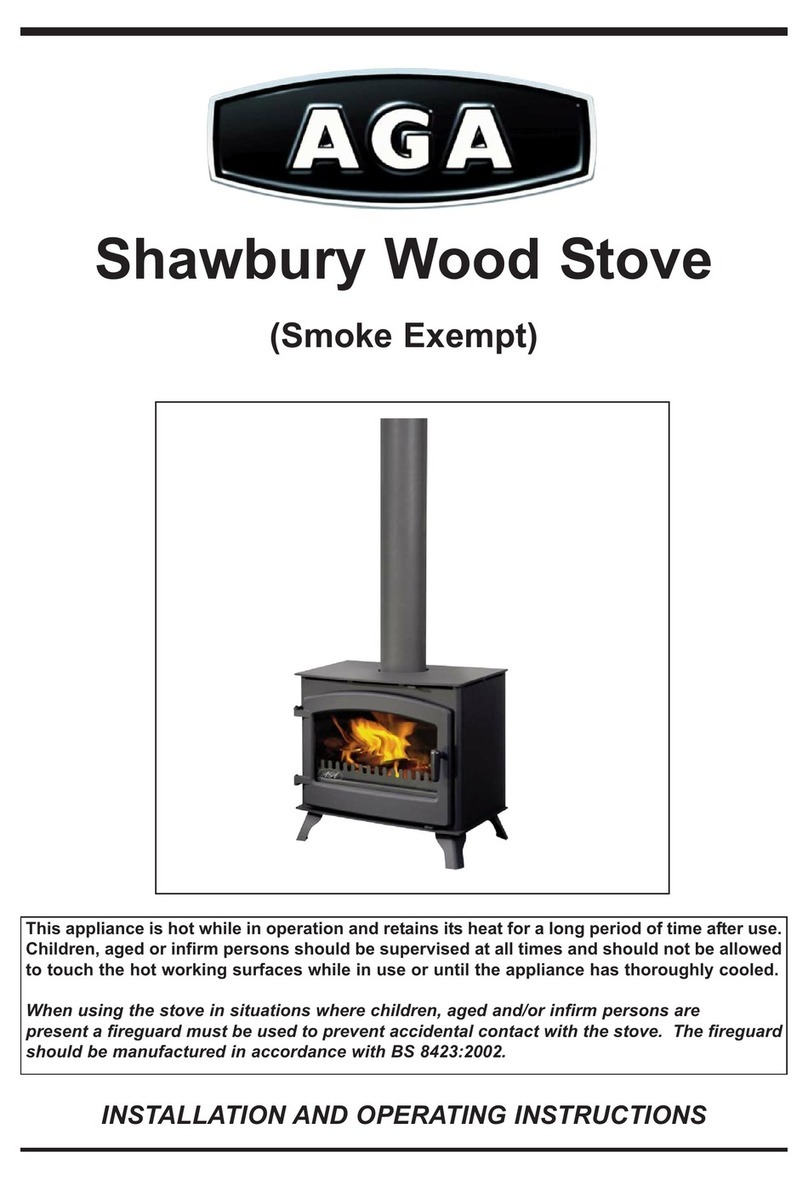
AGA
AGA Shawbury Installation and operating insctructions

NESTOR MARTIN
NESTOR MARTIN C13 Installation and operating instructions
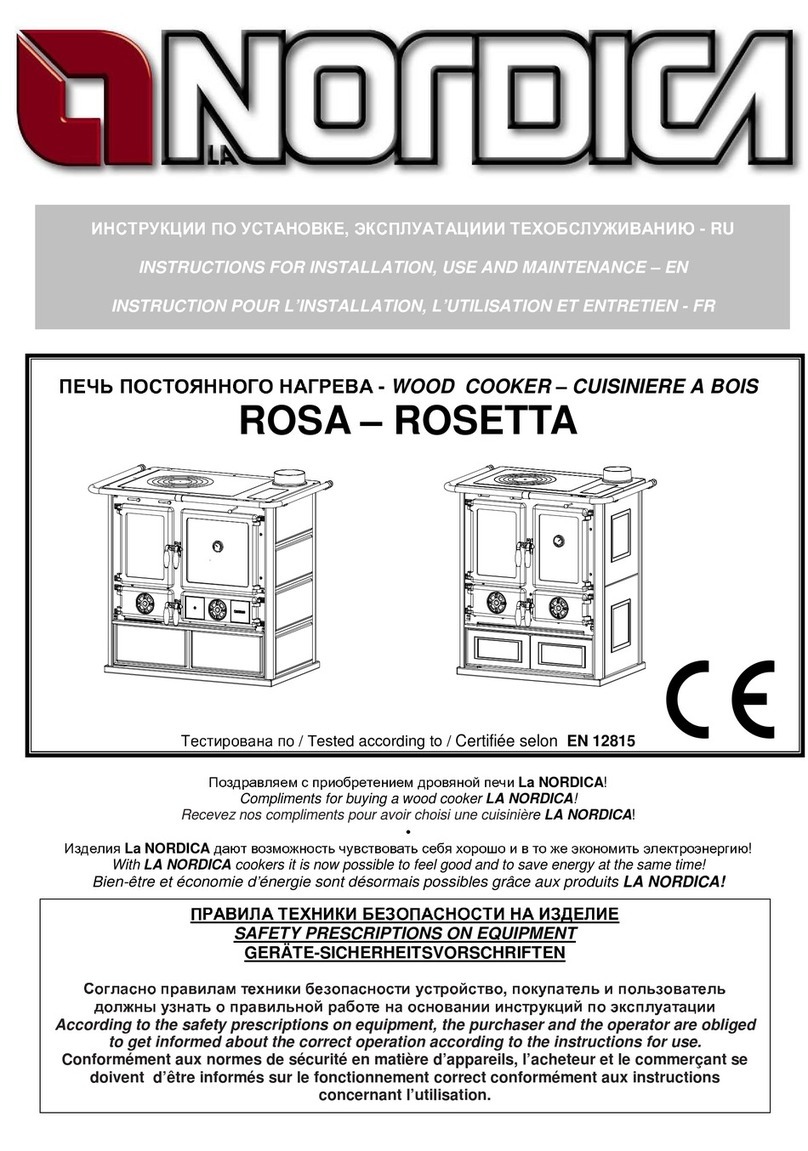
Nordica
Nordica ROSA Instructions for installation, use and maintenance
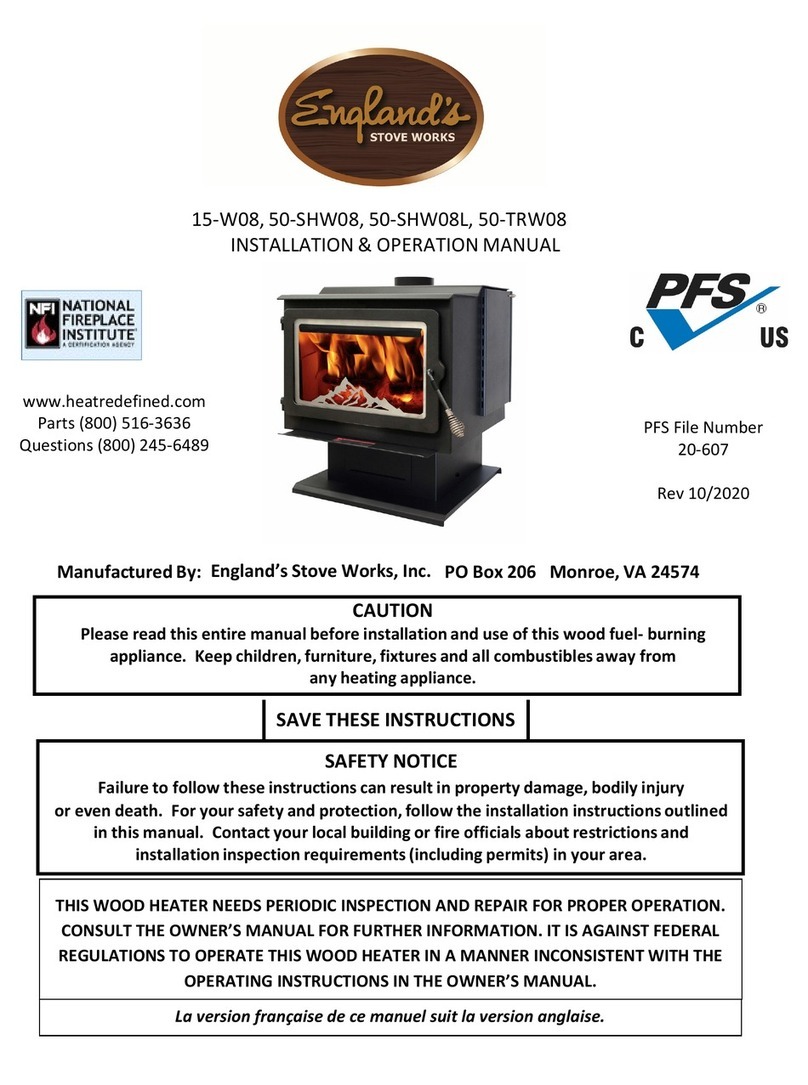
England's Stove Works
England's Stove Works 50-SHW08 Installation & operation manual

Golden Eagle
Golden Eagle ECONOMY SERIES 5040 Owner’s Instruction and Operation Manual
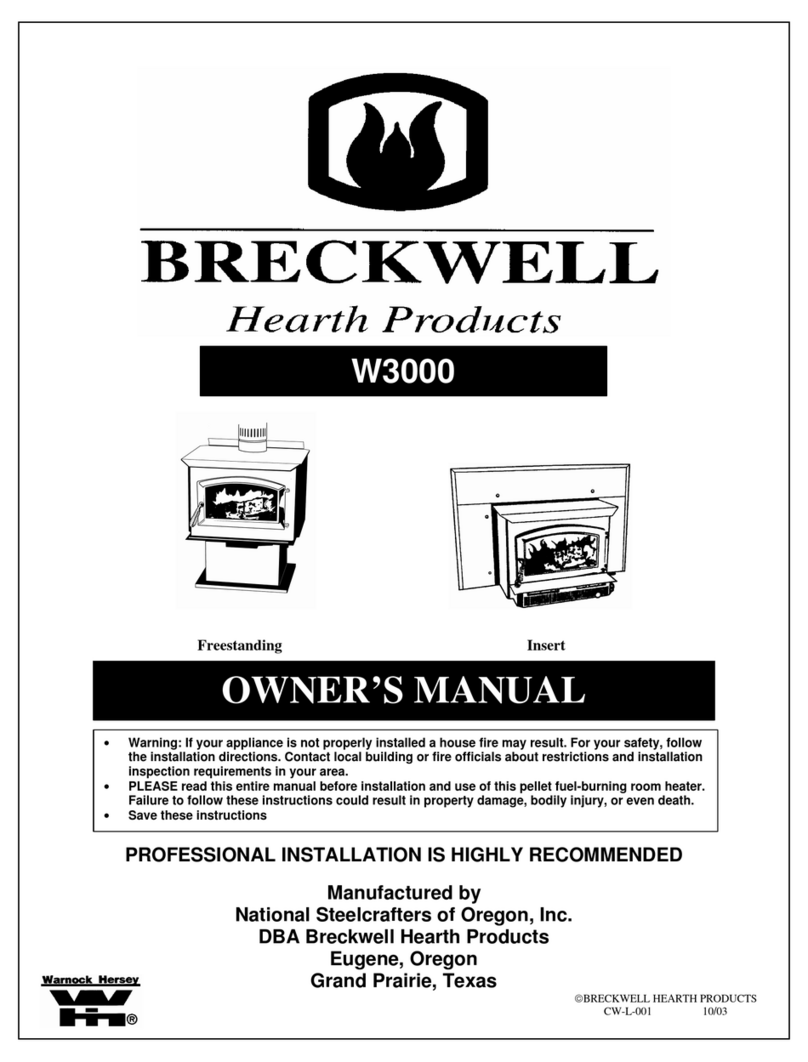
Breckwell
Breckwell W3000 owner's manual

Nordpeis
Nordpeis Salzburg XL installation manual
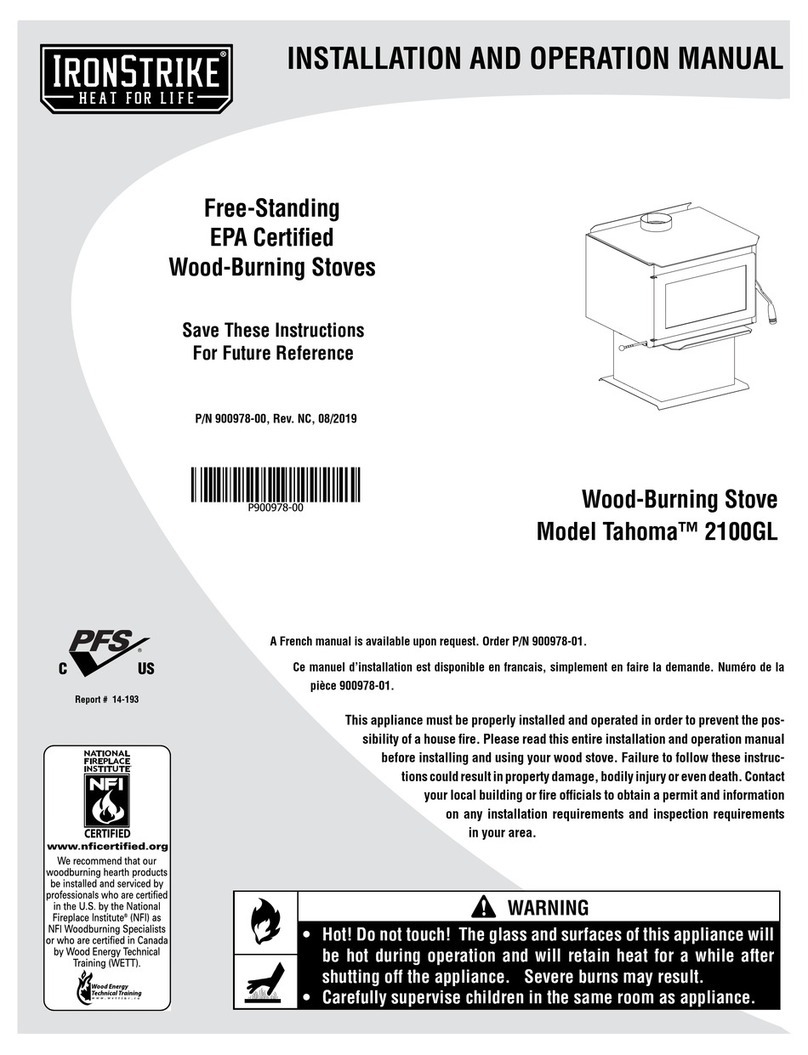
IronStrike
IronStrike Tahoma 2100GL Installation and operation manual
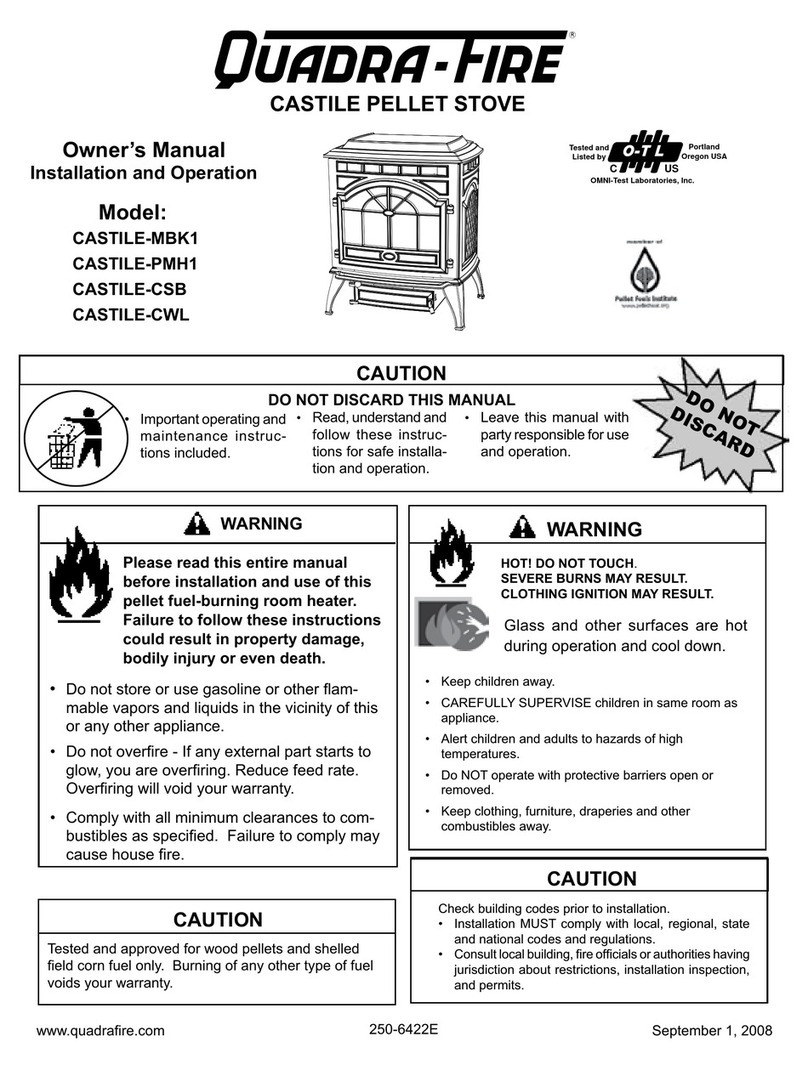
Quadra-Fire
Quadra-Fire CASTILE-CSB owner's manual
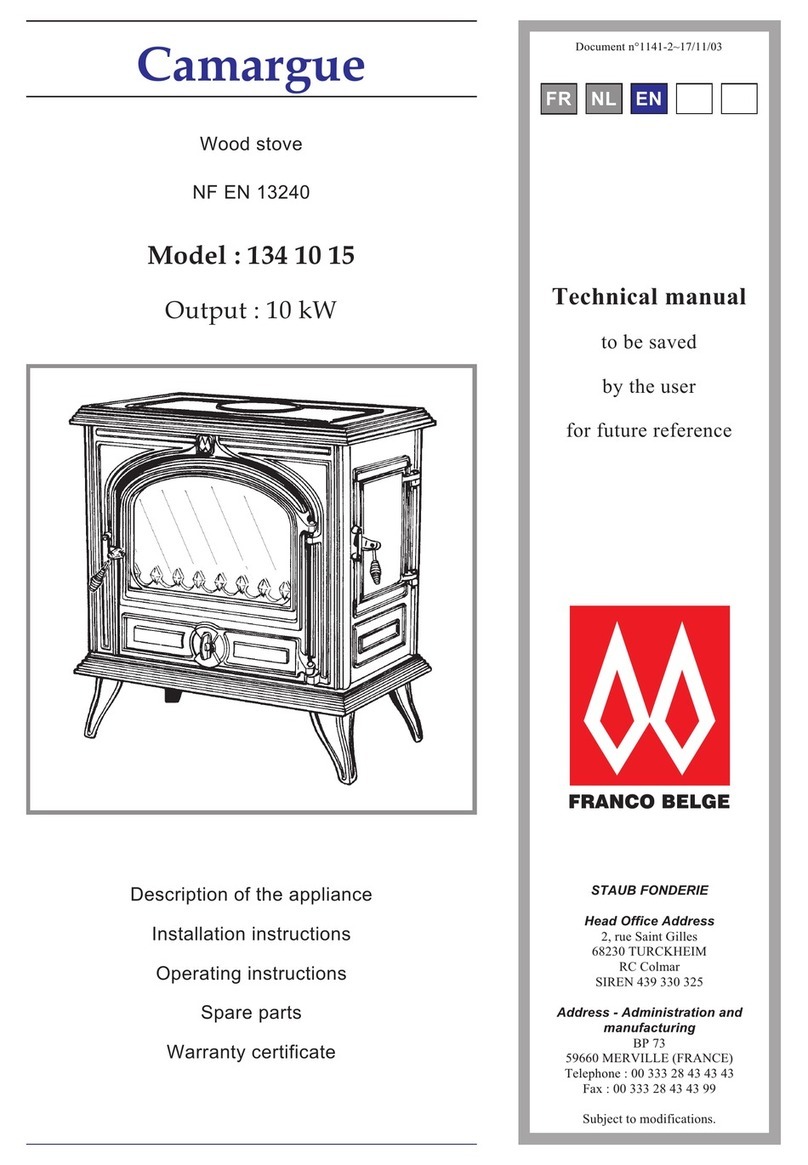
FRANCO BELGE
FRANCO BELGE Camargue 134 10 15 Technical manual
